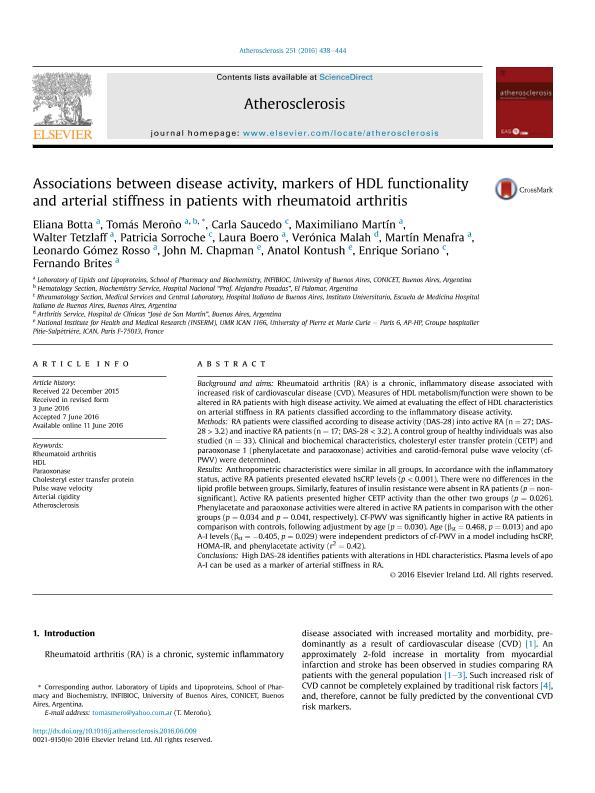Artículo
Associations between disease activity, markers of HDL functionality and arterial stiffness in patients with rheumatoid arthritis
Botta, Eliana Elizabeth ; Meroño, Tomás
; Meroño, Tomás ; Saucedo, Carla; Martin, Maximiliano Emanuel
; Saucedo, Carla; Martin, Maximiliano Emanuel ; Tetzlaff, Walter Francisco; Sorroche, Patricia Beatriz; Boero, Laura; Malah, Verónica; Menafra, Martín; Gomez Rosso, Leonardo Adrián
; Tetzlaff, Walter Francisco; Sorroche, Patricia Beatriz; Boero, Laura; Malah, Verónica; Menafra, Martín; Gomez Rosso, Leonardo Adrián ; Chapman, John M.; Kontush, Anatol; Soriano, Enrique; Brites, Fernando Daniel
; Chapman, John M.; Kontush, Anatol; Soriano, Enrique; Brites, Fernando Daniel
 ; Meroño, Tomás
; Meroño, Tomás ; Saucedo, Carla; Martin, Maximiliano Emanuel
; Saucedo, Carla; Martin, Maximiliano Emanuel ; Tetzlaff, Walter Francisco; Sorroche, Patricia Beatriz; Boero, Laura; Malah, Verónica; Menafra, Martín; Gomez Rosso, Leonardo Adrián
; Tetzlaff, Walter Francisco; Sorroche, Patricia Beatriz; Boero, Laura; Malah, Verónica; Menafra, Martín; Gomez Rosso, Leonardo Adrián ; Chapman, John M.; Kontush, Anatol; Soriano, Enrique; Brites, Fernando Daniel
; Chapman, John M.; Kontush, Anatol; Soriano, Enrique; Brites, Fernando Daniel
Fecha de publicación:
08/2016
Editorial:
Elsevier Ireland
Revista:
Atherosclerosis
ISSN:
0021-9150
Idioma:
Inglés
Tipo de recurso:
Artículo publicado
Clasificación temática:
Resumen
Background and aims Rheumatoid arthritis (RA) is a chronic, inflammatory disease associated with increased risk of cardiovascular disease (CVD). Measures of HDL metabolism/function were shown to be altered in RA patients with high disease activity. We aimed at evaluating the effect of HDL characteristics on arterial stiffness in RA patients classified according to the inflammatory disease activity. Methods RA patients were classified according to disease activity (DAS-28) into active RA (n = 27; DAS-28 > 3.2) and inactive RA patients (n = 17; DAS-28 < 3.2). A control group of healthy individuals was also studied (n = 33). Clinical and biochemical characteristics, cholesteryl ester transfer protein (CETP) and paraoxonase 1 (phenylacetate and paraoxonase) activities and carotid-femoral pulse wave velocity (cf-PWV) were determined. Results Anthropometric characteristics were similar in all groups. In accordance with the inflammatory status, active RA patients presented elevated hsCRP levels (p < 0.001). There were no differences in the lipid profile between groups. Similarly, features of insulin resistance were absent in RA patients (p = non-significant). Active RA patients presented higher CETP activity than the other two groups (p = 0.026). Phenylacetate and paraoxonase activities were altered in active RA patients in comparison with the other groups (p = 0.034 and p = 0.041, respectively). Cf-PWV was significantly higher in active RA patients in comparison with controls, following adjustment by age (p = 0.030). Age (βst = 0.468, p = 0.013) and apo A-I levels (βst = −0.405, p = 0.029) were independent predictors of cf-PWV in a model including hsCRP, HOMA-IR, and phenylacetate activity (r2 = 0.42). Conclusions High DAS-28 identifies patients with alterations in HDL characteristics. Plasma levels of apo A-I can be used as a marker of arterial stiffness in RA.
Archivos asociados
Licencia
Identificadores
Colecciones
Articulos(OCA HOUSSAY)
Articulos de OFICINA DE COORDINACION ADMINISTRATIVA HOUSSAY
Articulos de OFICINA DE COORDINACION ADMINISTRATIVA HOUSSAY
Citación
Botta, Eliana Elizabeth; Meroño, Tomás; Saucedo, Carla; Martin, Maximiliano Emanuel; Tetzlaff, Walter Francisco; et al.; Associations between disease activity, markers of HDL functionality and arterial stiffness in patients with rheumatoid arthritis; Elsevier Ireland; Atherosclerosis; 251; 8-2016; 438-444
Compartir
Altmétricas



